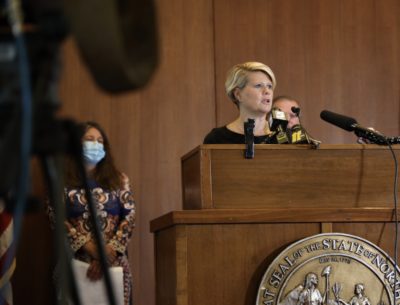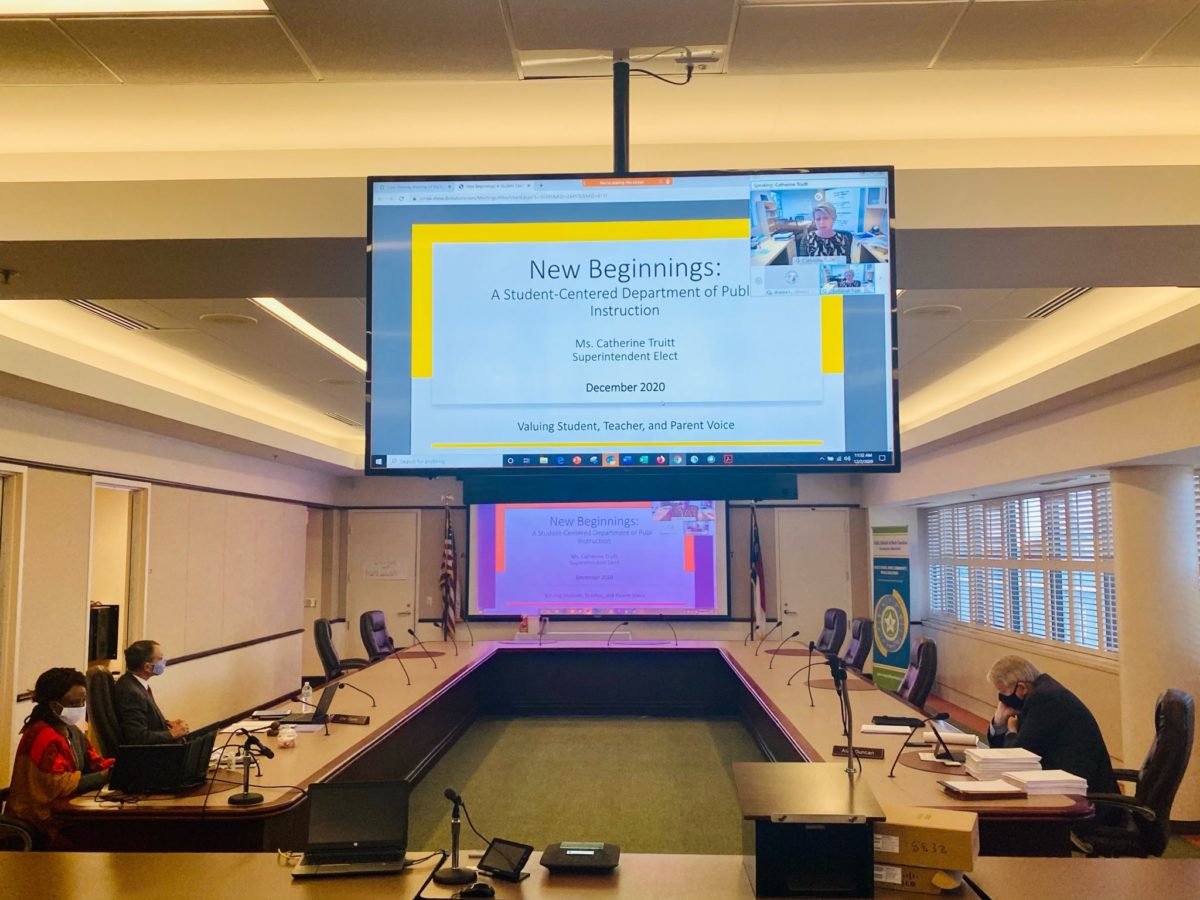

Note: Scroll down below this section to see more updates from this month’s State Board of Education meeting.
While state testing is going ahead as usual this year, the State Board of Education is pursuing a pair of federal waivers that will lower the stakes of the exams and ensure that no one is penalized if students don’t show up to take them.
During its monthly meeting this week, the State Board also discussed whether it will change the rule that such tests must count for 20% of a student’s grade.
“The unprecedented and irregular nature of this makes it extremely difficult to even fathom testing for the purposes of accountability,” said Board member James Ford in reference to the COVID-19 pandemic. He also said, however, that testing could be used just to get an idea of how much damage has been done to student learning as a result of the pandemic.
In December and January, middle and high schools around the state will be administering End-of-Course (EOC) exams as well as Career and Technical Education (CTE) tests in-person.
The State Board heard a presentation Wednesday explaining that the U.S. Department of Education has indicated no federal waivers will be given for testing this year. However, with President-elect Joe Biden taking office in January, that guidance may change.
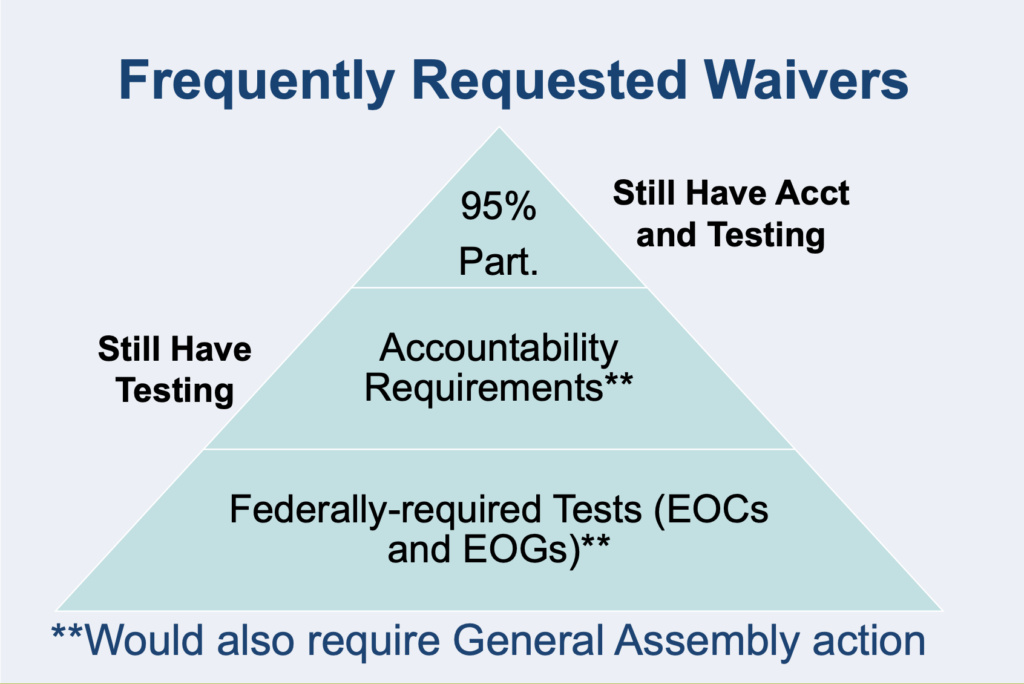

Since the federal government is not allowing districts to skip these tests, David Stegall, deputy superintendent of innovation and equity at the state Department of Public Instruction (DPI), told the State Board that DPI is recommending two alternate waivers. One relates to the requirement that 95% of students take state exams, and another is a waiver from the requirements that such tests be used to determine school performance grades.
For the 95% requirement, only a waiver from the federal government is necessary. A waiver from the General Assembly would also be required when it comes to the school performance grades, however.
Stegall said the number of students taking state tests this year will likely be lower than normal thanks to the pandemic and parents who don’t want their kids to go to school in-person. That will make it difficult to meet the 95% requirement, and it also means that accountability measurements could be skewed because of low turnout.
Even before consideration of the waivers, the state has provided some flexibility to districts in administering the fall exams (see below). The exams do, however, have to be taken in person.
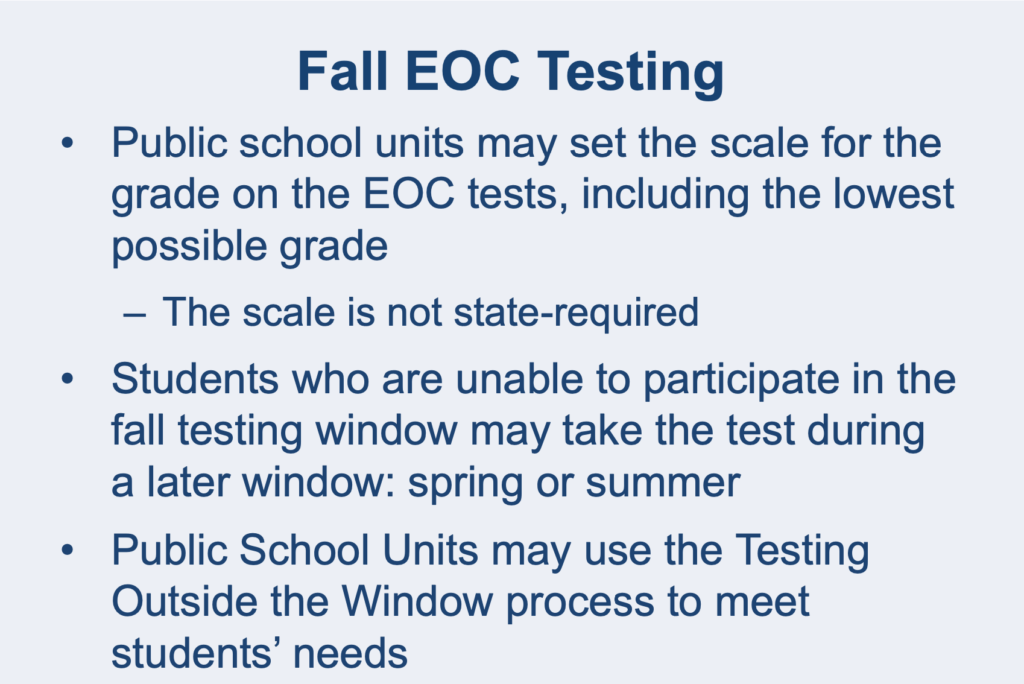

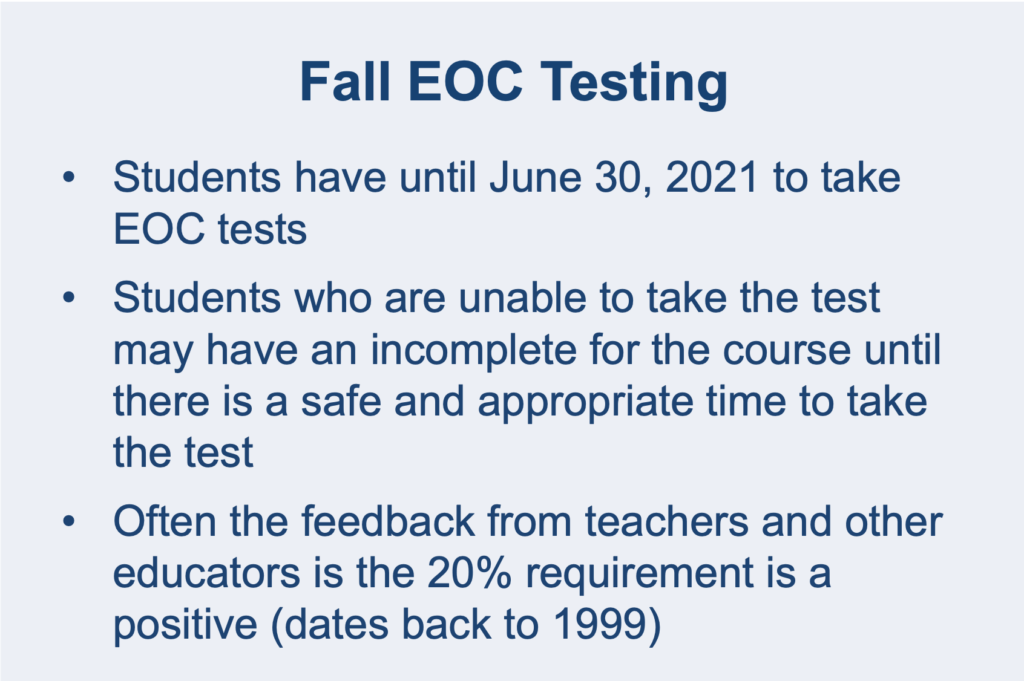

The Board will have a final vote in January on seeking the waivers.
The State Board also discussed an administrative rule that these tests count for 20% of a student’s grade. State Board member Jill Camnitz said that the rule has some practical benefits.
“This provides meaningful feedback on a student’s understanding of the course material, but it also serves to motivate our students to take the test and to take it seriously,” she said.
State Superintendent Mark Johnson, however, said that he has been receiving a lot of emails from parents concerned about the rule. He said Wednesday and again Thursday that the State Board should do what it can to change the 20% rule for the sake of students. He said the Board has the power to do so.
State Board Chair Eric Davis said Wednesday that the notion of eliminating the 20% rule reminds him of the State Board’s position back in the spring. At the time, the State Board made a decision to allow high school students to take a pass/fail for their courses. Some parents and students appreciated that, while others wanted letter grades to be administered.
“This is another one of those issues that sort of cuts both ways. And I think we really do need to think carefully about the ramifications of which way we go,” Davis said.
The Board made no decisions on the 20% rule at its meeting this month. Davis said it makes sense for the State Board to seek waivers for the 95% participation rate and accountability requirement before taking up the rule that makes the tests count for 20% of a final grade.
Below is the full presentation.
COVID-19 update
The State Board heard a COVID-19 update from staff at the state Department of Health and Human Services (DHHS) on Thursday.
According to the presentation, the number of COVID-19 cases in K-12 schools remains relatively low.
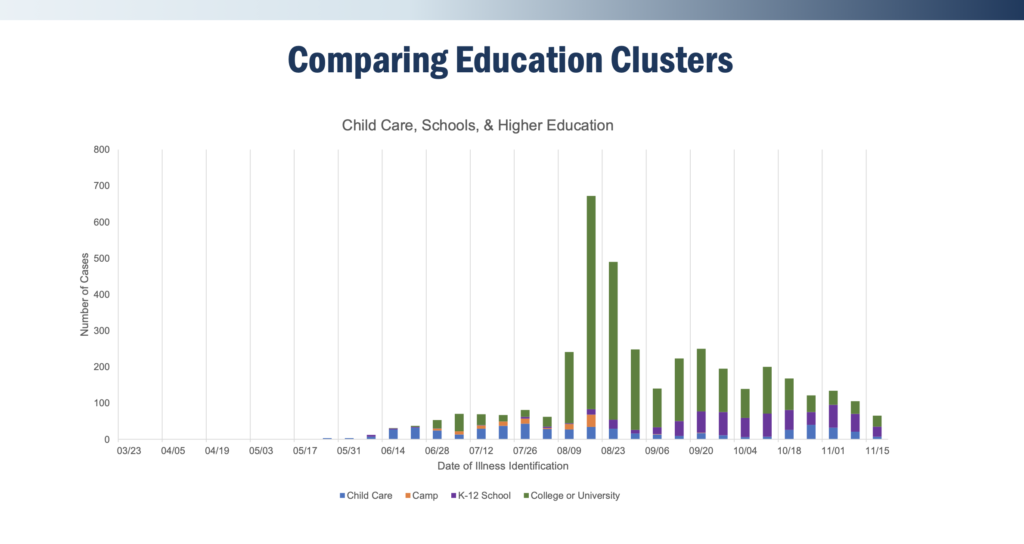

As of the end of November, North Carolina’s schools had 31 active clusters — 309 total cases encompassing 207 students and 102 staff. The most cases and clusters are occurring in private schools, according to the DHHS data.
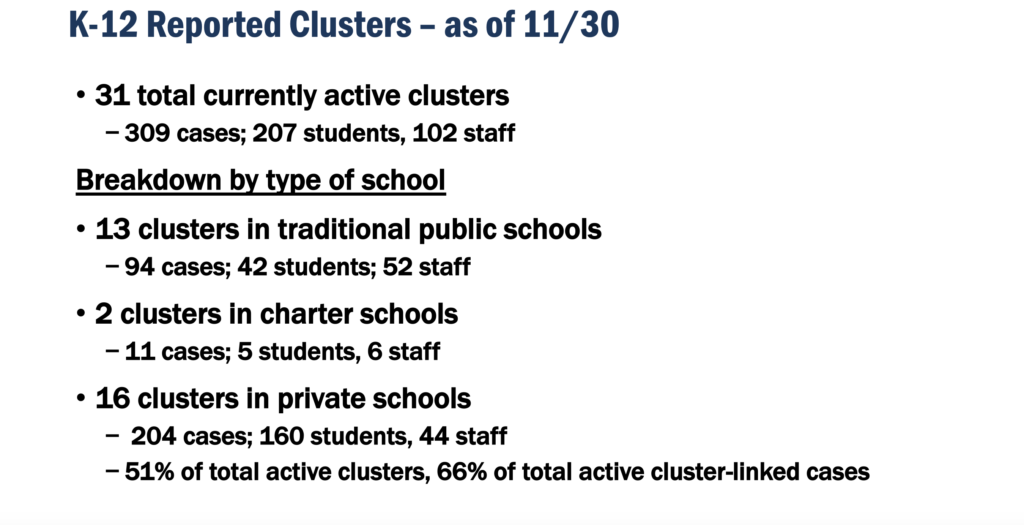

DHHS staff also discussed the launch of a free pilot program using antigen tests to detect COVID-19. These kinds of tests are meant to be used “for rapid diagnosis of active infections within 5-7 days of symptom onset.”
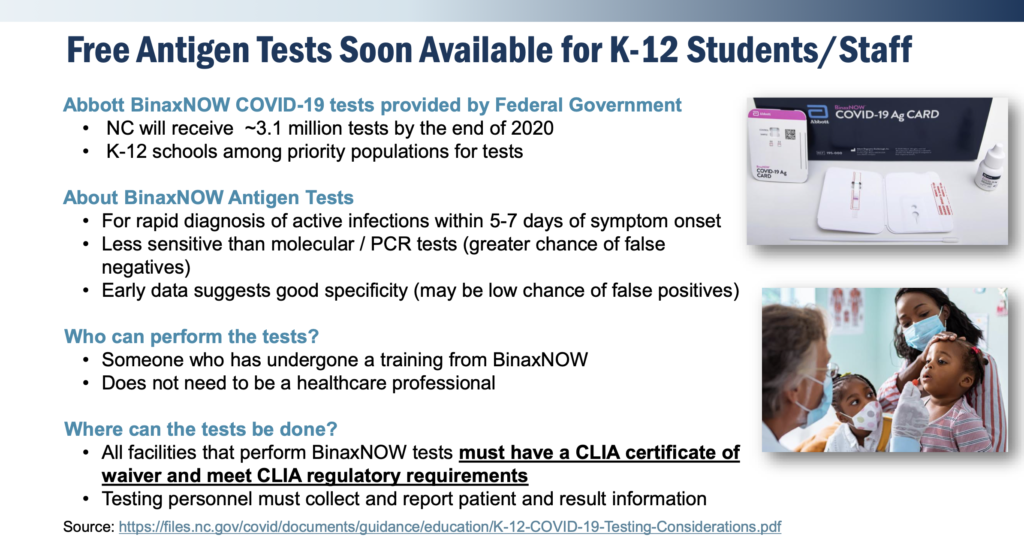

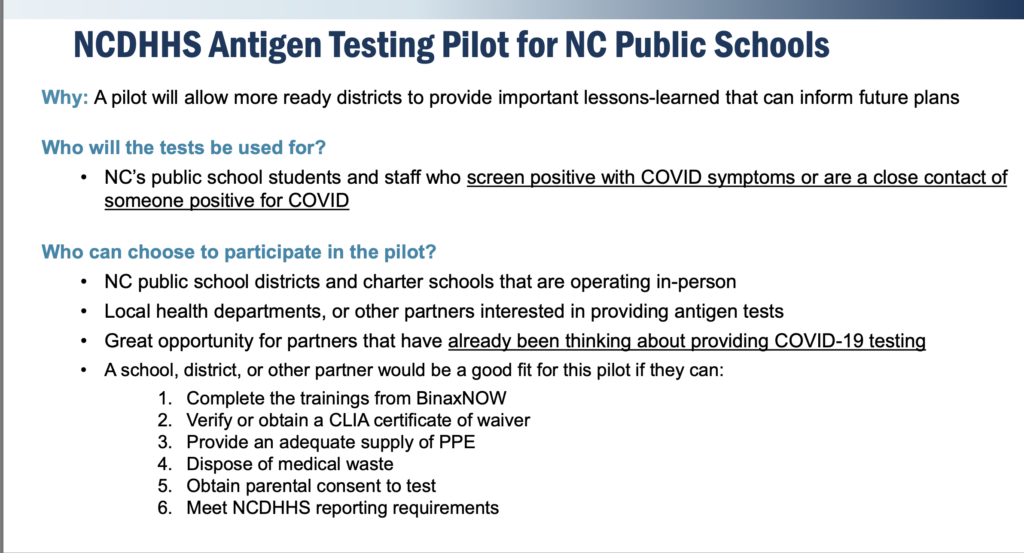

Here is how districts can apply.
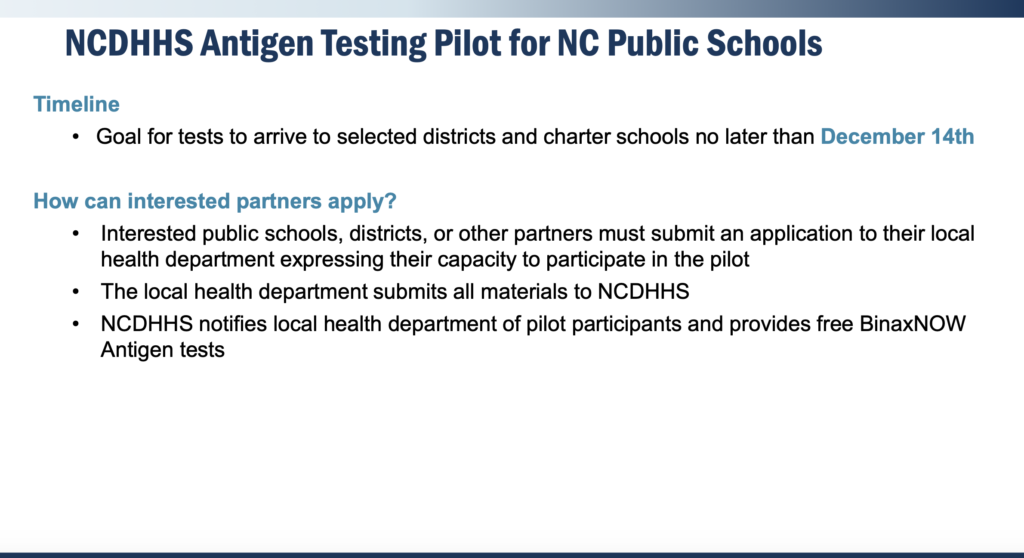

Here is the pilot timeline. DHHS staff said that parental consent will be necessary to test students.
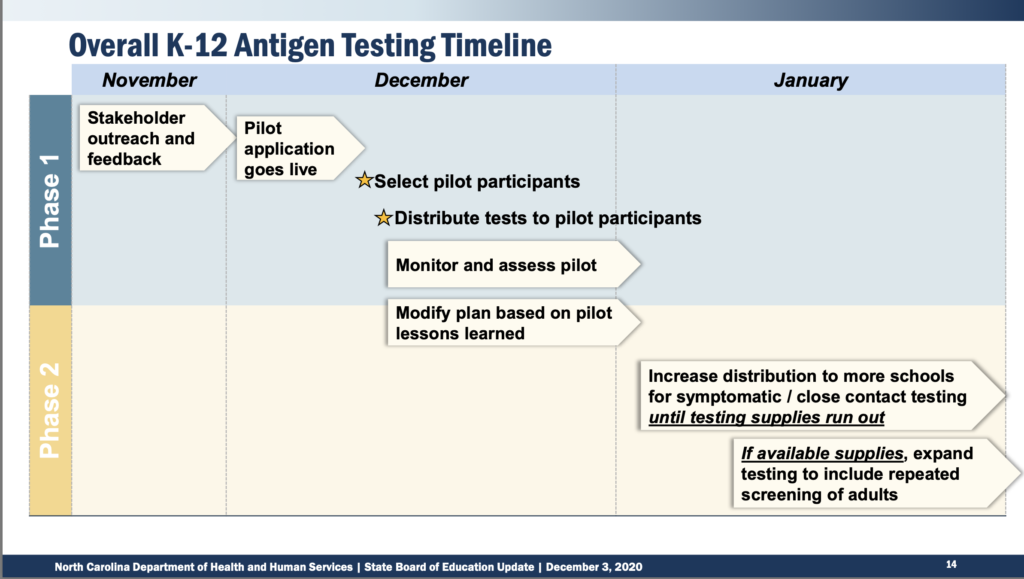

Now that the United States is seeing COVID-19 vaccines on the horizon, DHHS has developed a plan for prioritizing distribution. See that framework below.
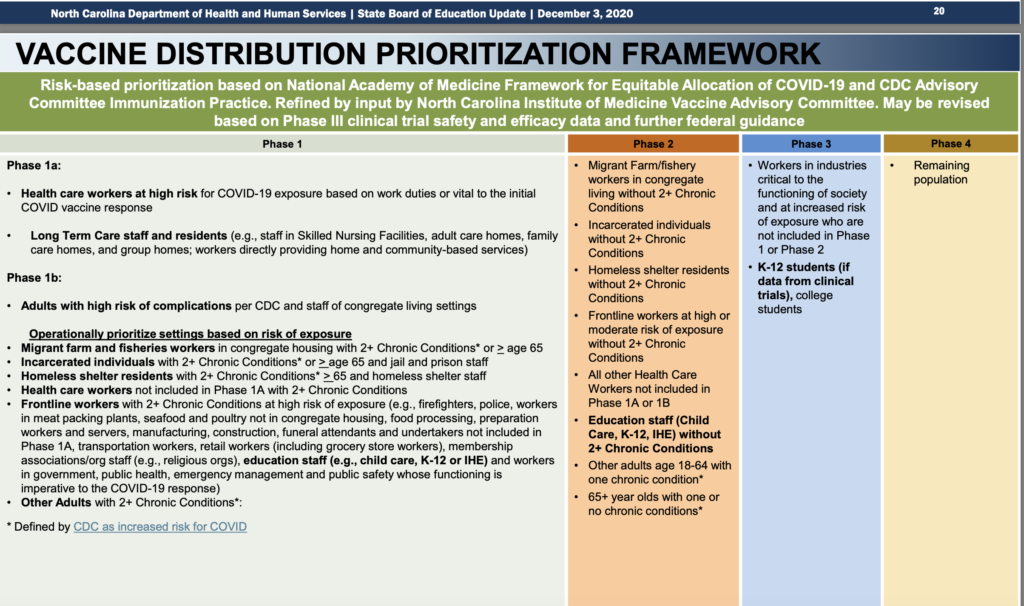

And here are the “guiding principles” behind the vaccine distribution plan.
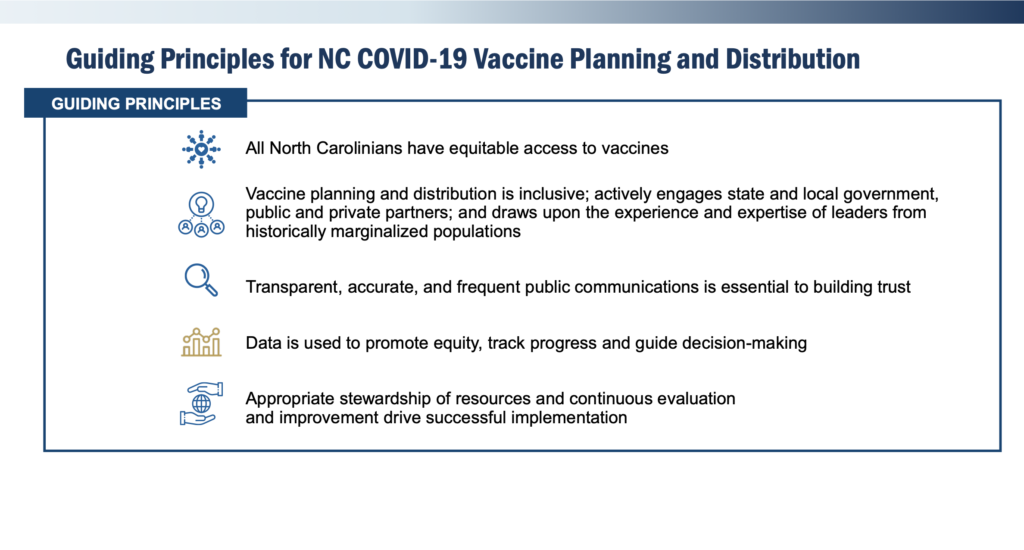

DHHS said that once a vaccine is approved, it will take a while for it to become available to everyone, but that the state will receive a limited supply at first.
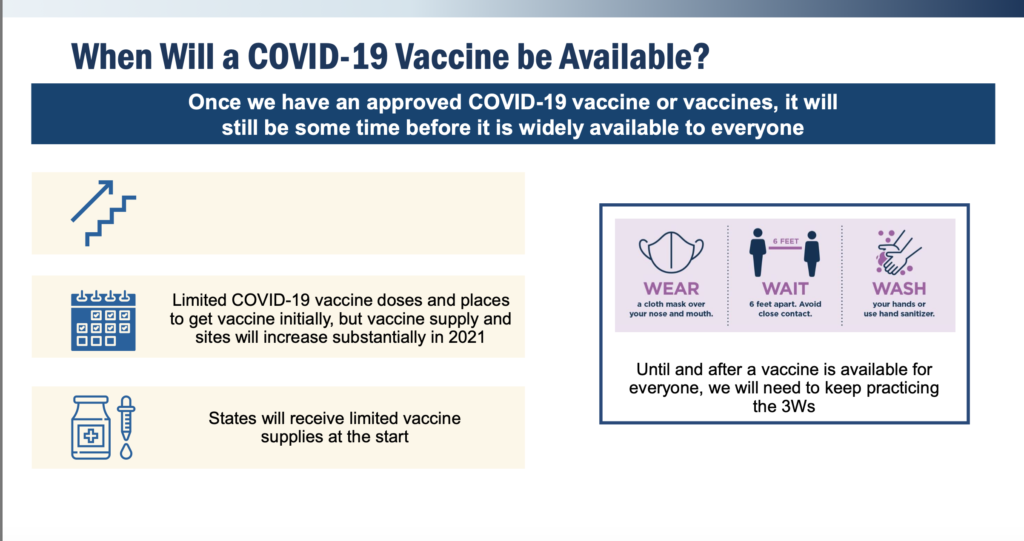

State Board member James Ford said that when it comes to the Black population, there is a lot of inherent distrust with government about things like vaccines because of “breaches in trust” that have occurred in the past. He asked DHHS staff to keep that in mind as they work to communicate their vaccine plans.
Below are the updates to DHHS guidance in schools.
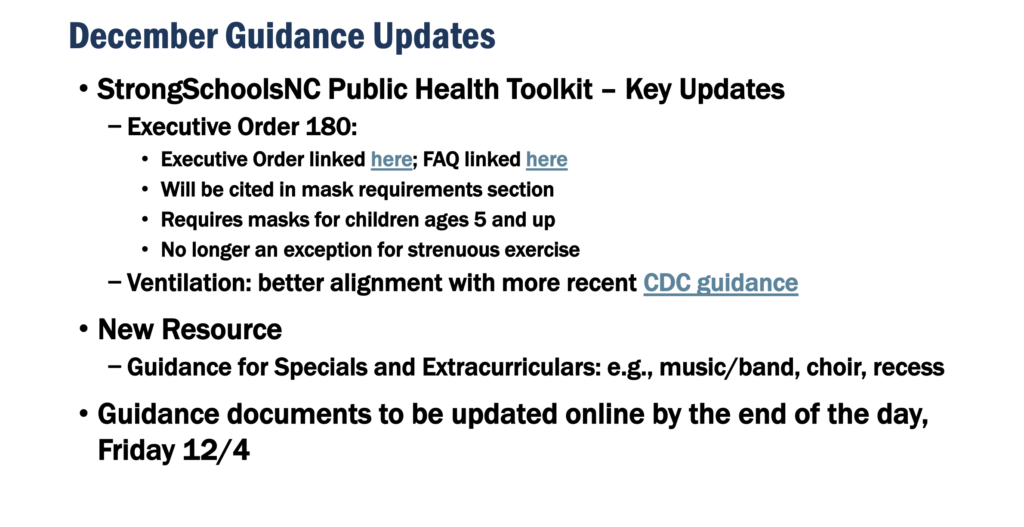

See the full presentation below:
Superintendent Mark Johnson’s last State Board meeting
On Thursday, State Superintendent Mark Johnson gave his last superintendent’s report. In January, Catherine Truitt will take over as state superintendent.
Here is a transcript of what Johnson said.
“Thank you. This is my last superintendent’s report, but like all the rest, I will keep it brief.
“It has truly been an honor and a privilege to serve as state superintendent. It has been a fight. Everyone sees that and reads about it, but it has been a fight well worth fighting and has resulted in positive changes that were long overdue.
“Another education leader commented to me that I actually was able to fit 12 years of change into just four. We did that. We responded to educators. We took steps to reduce testing. We got more funding out of Raleigh and into schools. We’ve transformed how our state will pursue the goal of improving the reading abilities of our youngest students with more focus on best practices and curriculum, more professional development and support, and by switching to computer-adaptive reading diagnostics.
“But a major change that is extremely important to our schools, but doesn’t get as much attention, was the change in leadership at the Department of Public Instruction. There’s a very true but short saying: ‘Nothing changes, if nothing changes.’ DPI was able to put together an amazing team, and many on this team were already here before I arrived and were kept in place in leadership or, just as important, we promoted into leadership roles. Some were outstanding leaders from outside DPI who we were able to bring into the department.
“And I am excited to announce that the last person that I’ll be bringing in, as already announced by Superintendent-elect Truitt, is Superintendent Derrick Jordan will be joining us to help lead the specialized schools that are part of the agency, and we’re excited to welcome him and very grateful that he wants to step up and take on this very important role.
“The greatest testament to the improvements at DPI has been this agency’s response to the COVID-19 crisis. We transformed from a department of ‘no’ to a department that figured out how to help schools get to ‘yes.’ And this same leadership will continue for years even after I am gone. And I’m very glad that that leadership will remain at DPI because our state and nation are facing a tsunami of learning loss in the next year because of this pandemic. Educators and parents are working hard and doing the best we all can to avoid it, but we all know it is out there, and it is about to hit.
“I encourage everyone to continue our efforts to implement personalized learning for all. We must meet students at their skill levels and help them proceed through school at their pace instead of getting left behind. With all of the federal funding during this crisis, we now have the technology in every school district to make this a reality. Also, educators and parents must put aside the stigma of which grade a student may technically be in on paper or if a student has to take more time to master concepts and continue to move to competency-based learning.
“This pandemic has taken away lives and livelihoods, and for those that are fortunate enough not to have lost a loved one or their job, it has at least taken away a year. Adults will be able to rebound more easily at the end of this crisis than our children. We must work to avoid these potentially negative consequences for what could be, if we don’t take the right steps, what could be known as the COVID generation. I know that is what my wife and I will decide for our young daughter. If it means she needs to repeat materials in the next school year, that is what we will make sure she does so that she is successful for the rest of school and for her whole life.
“I will end on a positive note. We are again this year asking school children to send us holiday cards for our servicemen and women who will be stationed away from home this season. While it may look different this year, we are thrilled to be able to do that and show support to the numerous servicemen and servicewomen who are stationed away from home during the holidays, especially during this challenging year.
“We launched this last year, and it really is a terrific program. We got over 50,000 holiday cards, and we really thank the people in North Carolina for doing that with us. So I’ll leave you with happy holidays, merry Christmas, and we can all celebrate that there are now less than 30 days left in 2020. Thank you.”
State of teaching report
The number of teachers leaving the profession in North Carolina is down slightly from two years ago, according to a report presented to the State Board of Education on Thursday. The number is, however, very close to the same as it was last year. Teacher mobility — teachers moving between districts — is up from two years ago and last year.
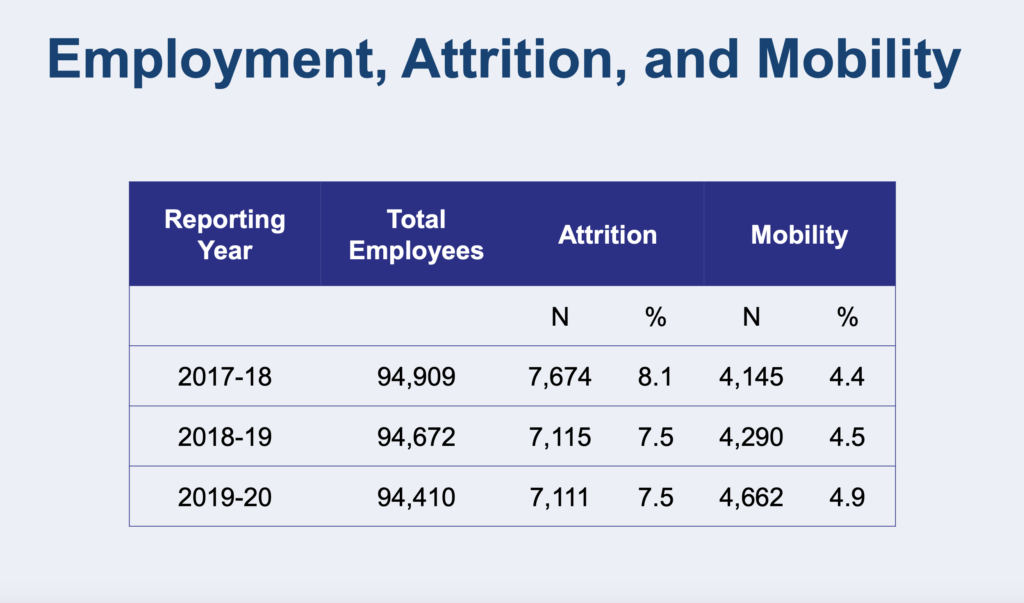

The data in this presentation and report was captured prior to the outbreak of COVID-19, so it doesn’t reflect any impacts from the pandemic. Those impacts will be recorded in next year’s reports, according to DPI staff.
The highest percent of teachers no longer teaching in North Carolina are the state’s newest teachers and most veteran.
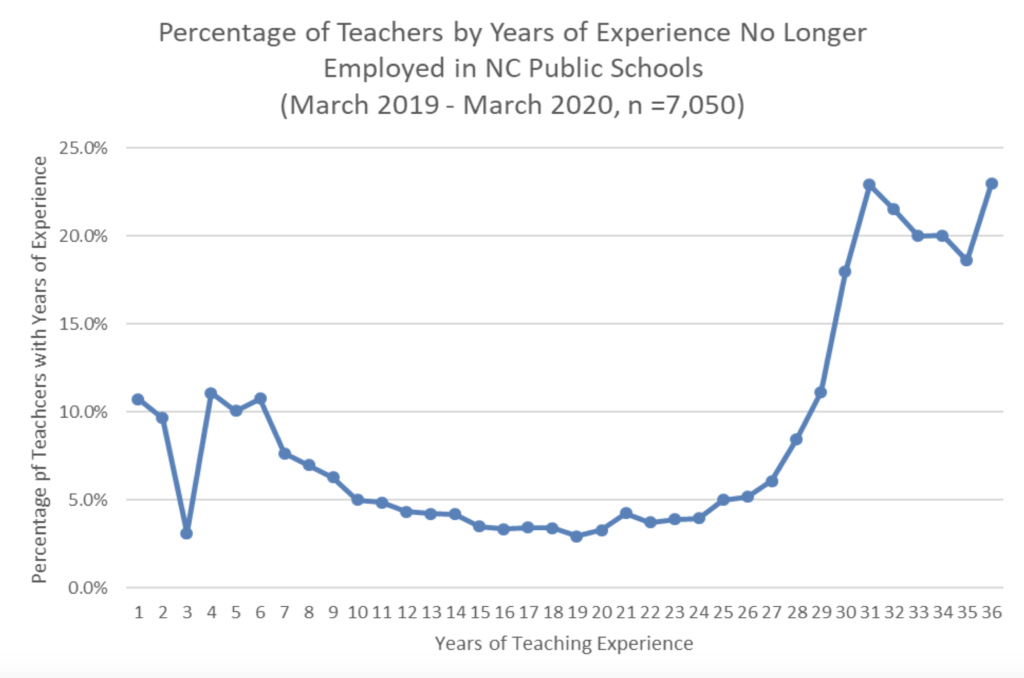

Here is the data on attrition broken down by type of teacher.
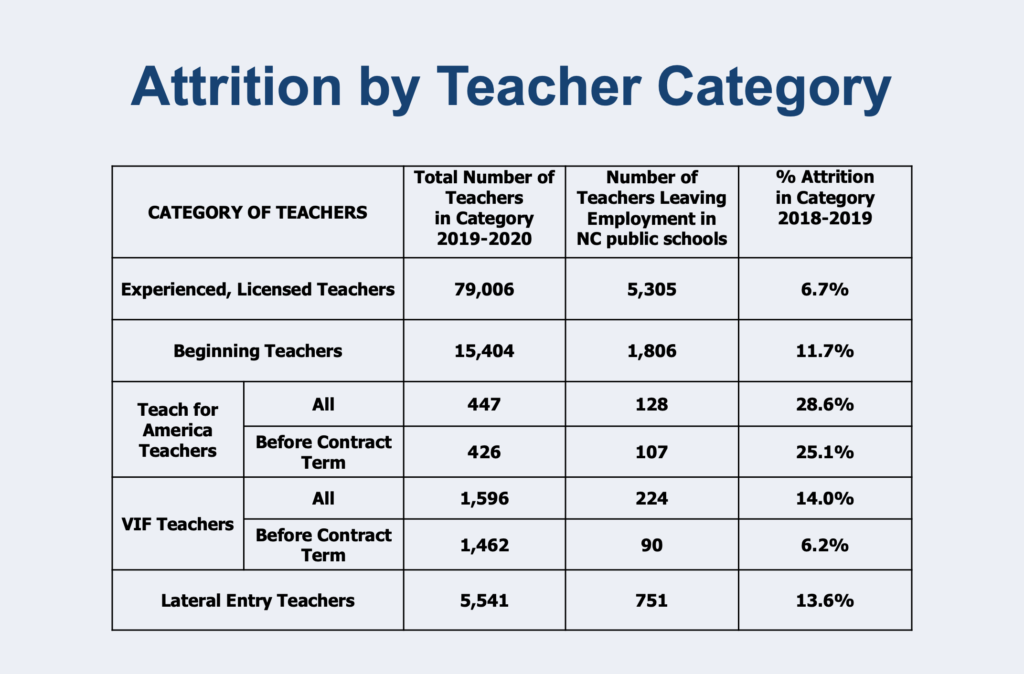

Most of those teachers who left the profession gave “personal. reasons” as their motivation for leaving.
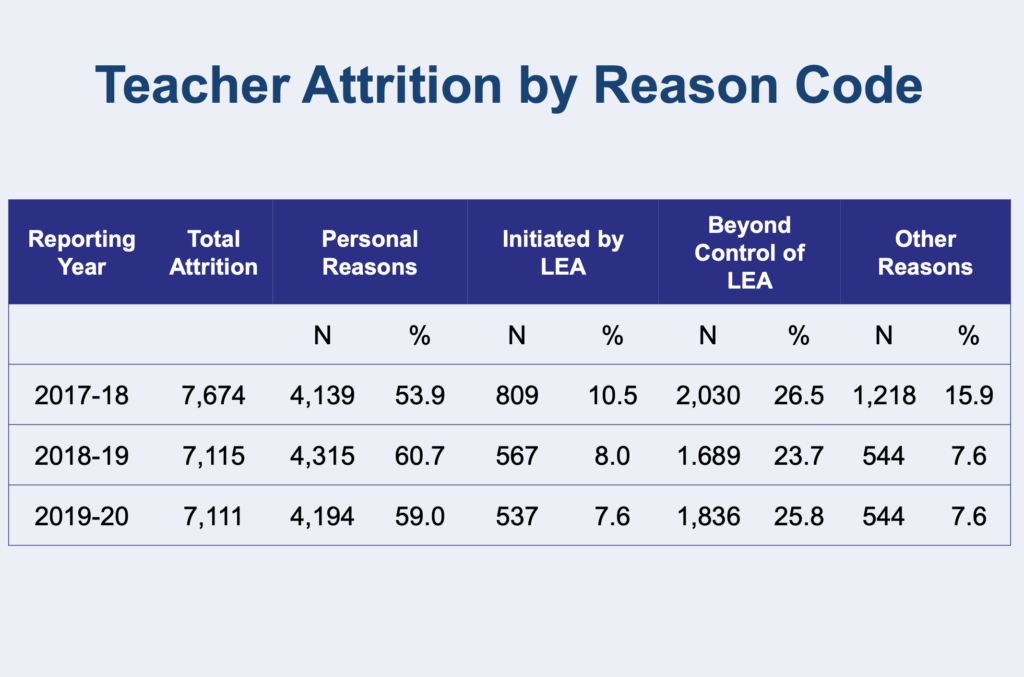

Here is more detail on why teachers left the profession from the draft report on the state of teaching.
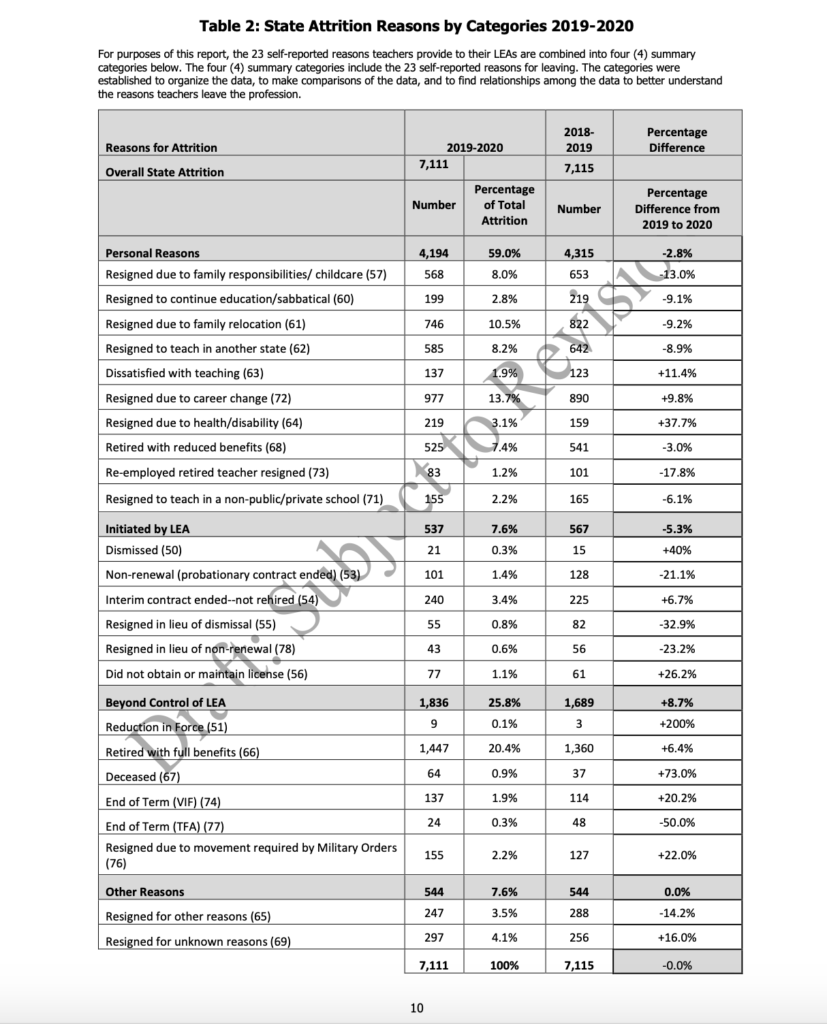

Here is a chart showing the teacher attrition by region of the state.
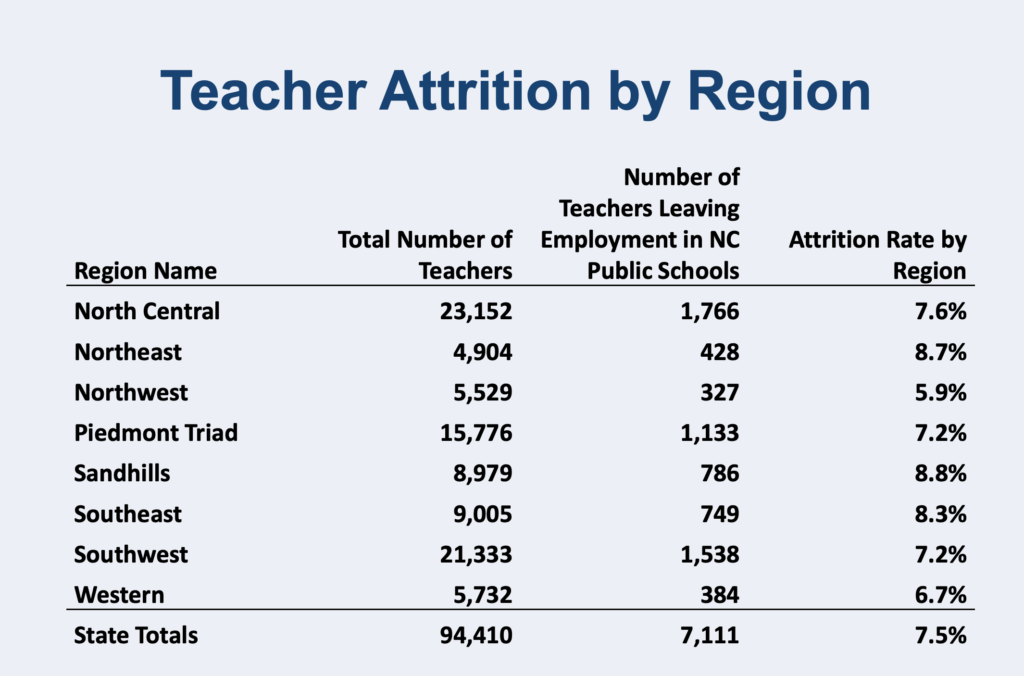

And here is a chart showing the five school districts with the highest and lowest attrition rates.
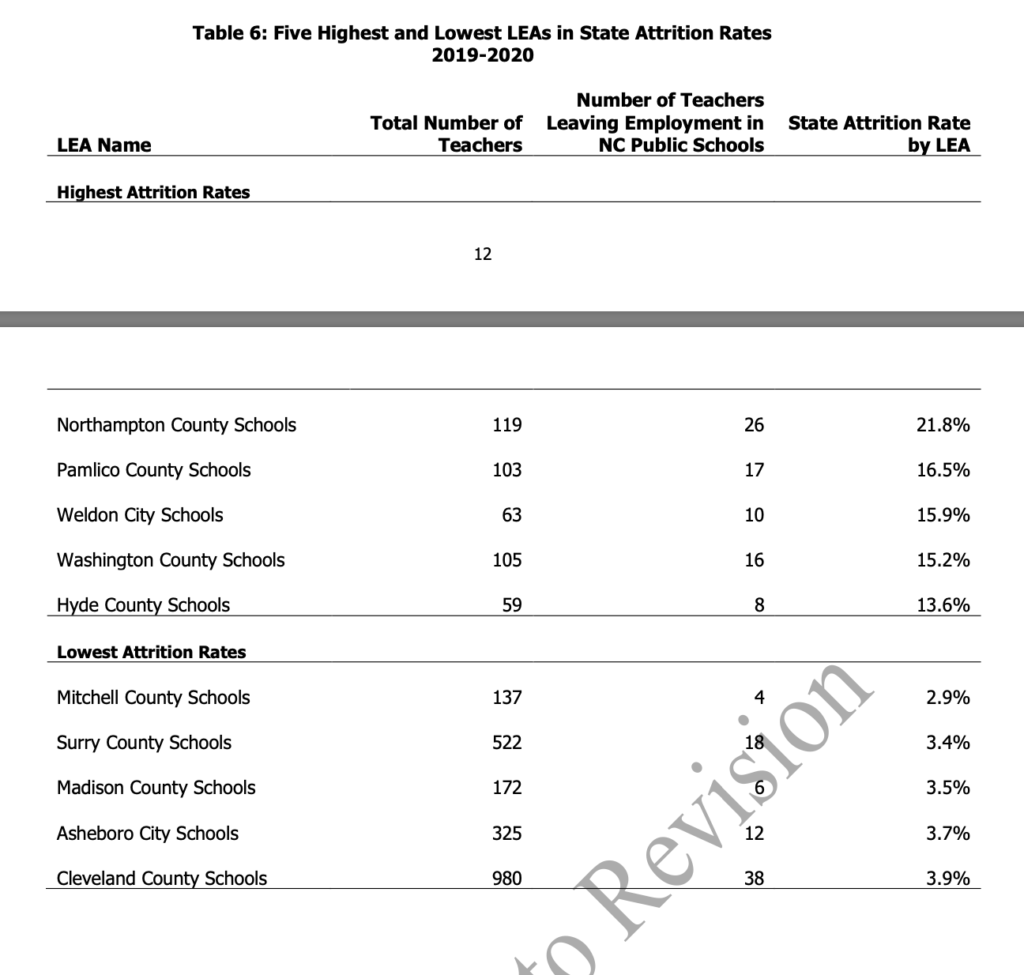

Here is the full presentation.
Here is the draft report.
Legislative priorities
The State Board also discussed proposed legislative priorities for the spring long session of the General Assembly. The Board will finalize their priorities in January.
The line items presented changed some from what the Board saw at its meeting last month, and the total amount of funding increased.
Full funding of the listed priorities would require about $514 million from state lawmakers.
Here are the tentative line-items:
- Almost $5 million for early grades reading
- More than $143 million for teacher preparation, professional learning, and pay
- More than $27.5 million for principal preparation, professional learning, and pay
- More than $208 million for student mental health
- Almost $82.5 million for school and district turnaround assistance
- A little more than half a million for School Accountability and Teacher Effectiveness Models
- More than $10 million for “Connecting High School to Postsecondary and Career Opportunities”
- More than $2 million for state Department of Public Instruction support positions
- More than $34 million for “Other Agency Budget Requests”
The list and prioritization of funding could change between now and January.
Here is the whole presentation:
Getting and keeping teachers
The State Board also heard about teacher licensure and how to ensure a high-quality teacher is in every classroom in the state.


